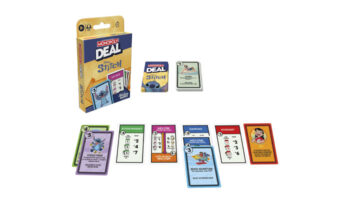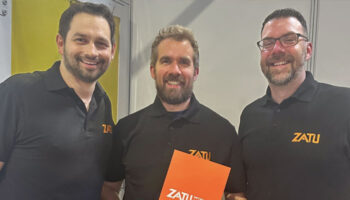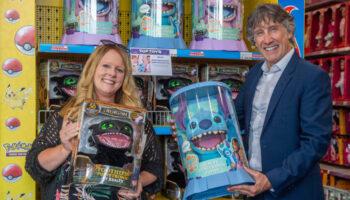Hunch Studios’ Peter Levin and Javier Quinonez on creating games that pass the 10-second TikTok test

Guys, thanks for making time. Talk me through your route to launching your own game design studio in Hunch. Was it always part of the plan?
Peter Levin: We grew up playing games, but “games as a career” was never an early thought. Javi and I met as roommates studying abroad; him from Kansas State, me from UMass Amherst. After that junior year, we went on to do roughly every venture together… Co-managing a State Senate campaign that ended in a blowout loss. Co-founding a mobile payments start-up that ended in an acquihire.
Javier Quinonez: Then we went on to do the corporate thing for a little bit. But after a few years of that, we knew it was time to get back into creating – even if on the side – and started shortlisting some ideas, including one for a game…
That was Incohearent?
PL: Yes! By coincidence, we had known the creator of What Do You Meme? for many years before he was doing games – we were both running our start-ups. So, after we had our little Fedex prototype, he was our first call and the rest is history. We ended up partnering with them on bringing it to life.
JQ: It climbed to the number one spot on amazon after two or three months. That’s when it hit us: “Woah, this games thing could really be our thing!” Incohearent launched August 2019 and we were out of our corporate jobs and all-in on this by March 2020.

Amazing. And how do you work together on games?
JQ: We tag team the entire process together. One of us will have an inkling of an idea, then the other will piggyback– trying to elevate and shape it. Then we’ll prototype the game – mocking up the box, cards, developing the content. It’s a very collaborative process.
PL: And since we do the art and content ourselves, we can fast-track playtests with prototypes that are quite close to market ready. Which has been refreshing [creatively] compared to product development at our payments start-up – where each feature had to be deliberated, spec’d out, handed off to a developer and so on before we could get a read on demand.
Some of your games strongly tap into trends – like your Tell Me Without Telling Me game with Spin Master. Do you look for trends to engage with, or does the game always come first?
PL: We’re probably more inspired by social media behaviours, which are evergreen, versus trends, which are fleeting. However, if we can use the name recognition of a trend to give our game a little “power up” while standing on shelf – that’s a cherry on top. This was the case with Tell Me Without Telling Me. It happened to be a popular charades-adjacent trend, and thus, a reasonable choice for naming a charades-style game.

JQ: To build on that, our game If You Know You Know – or our latest one with Spin, Tag Someone Who – tap into this. These are widely-used online behaviours and forms of speech that have proven the test of time.
We also ask ourselves: “Can you make a 10-second TikTok about this game?” If the answer is “Yes”, then that means the game explains itself – that’s the gold standard when it comes to a party game. It has to pass the 10-second TikTok test!

The 10 second TikTok test! Like it! So, on Tag Someone Who, how did that come about?
JQ: You’ see those ‘Tag a friend who…’ memes on Instagram all the time, which already played as a social media-native voting game of sorts. This was the eureka. Could we create a whole game where the group has to “tag someone who” plus “insert relatable character trait”. For example: “tag someone who would kill it on Onlyfans” with an image of a bulldog sticking its butt in the air.
We went through a long process of sourcing stock imagery and pairing it with captions, or the converse, brainstorming relatable captions and trying to find imagery that “completed the prompt” in a tasteful, clever way. After building a list of 100s of these pairings, we shortlisted down to 175 of the funniest, most relatable cards.

PL: “Relatable” is key too – each card should remind you of at least one person that fits the character trait being portrayed. This lends itself quite well to social as well… If you post a picture of the card, people who follow you are then inclined to think about who fits the card and share the post with that person. Much like with Incohearent, the best types of games become tools for content creators.
Smart! A game with built-in viral potential…
PL: But it’s very hard to do that with a game! The cards should be entertaining enough to warrant posting, regardless of how entertaining the person behind the card is. It’s partly why we’re so bullish about the Tag Someone Who brand broadly.
Yes, tell me about the Tag Someone Who brand beyond the game.
PL: We’ve started incubating an adjacent media property of the same name dedicated to creating content “you want to tag your friends in.” It doubles as great lead gen for the game – ‘If you like tagging your friends online, tag them IRL with our game Tag Someone Who!”

JQ: We also have a media property called Wanna Play? where we play mini-games with strangers in New York City. Peter and I go out into the streets and we’ll play something like Incohearent, and that content will go viral. Right now we have around 275k followers. It’s been a great platform for us to stress-test content and ideas before productising something physical. We actually have a new game launching next year that we tested through it!
@wannaplaytv Can YOU Guess This Gibberish Phrase? #games #trivia #guessthegibberish #incohearant #hunch #hunchstudios #wannaplay #wannaplaytv ♬ original sound – Wanna Play? TV
We’ll put a video from the channel in there! It’s a compelling way to test ideas – and one that clearly works.
PL: There’s a practical reason we do it too. Toys and games are challenged as a product category – low price point, single purchase, seasonal. So it’s quite important to make products that will sell themselves!
It’s a great point. What are some of the pitfalls around inventors – and companies – chasing concepts designed to go viral?
PL: Often, you end up in the “fast start, fast death” bucket if you over-index on this. Which is why chasing concepts designed to go viral still falls second to having a strong core mechanic.
I wanted to ask you about another one of your recent games – Who Killed Mia? This is with Relatable and is a fresh take on the murder mystery format.
JQ: Yes, we wanted to design a murder mystery game grounded in pop culture that felt very current and would captivate someone today. It’s about an influencer who is killed live on Instagram. We focused on ‘if an investigation like this happened today, how would it unfold?’ Every part of this game experience honours that, from breaking into the victim’s phone to sifting through physical documents…

I imagine designing a murder mystery game is very different undertaking to a party game.
PL: Big time. Initially, we tried to outsource a lot of the writing – we hired a New York Times bestselling author in the true crime category. We hired a reporter working on the crime beat for a major newspaper… But it just didn’t work. With these types of games, you can’t write a story and then integrate a series of puzzles after-the-fact without it feeling brute forced. It’s a Venn diagram of “compelling story” and “compelling puzzles” that you need to hit the centre of out of the gate and throughout the process. So we did it! We’d write, trash it, write, trash it…
What were some of those reasons for trashing it and starting over?
PL: If characters felt underdeveloped or the puzzles felt unnatural within the story. And when one element doesn’t hit, there’s a ripple effect; many others have to be erased. We’d knock down the dominos and set them back up again. Who Killed Mia? is by far our most creatively ambitious game.
JQ: And the whole thing doesn’t start with you having to read a 2,000 word introduction leaflet. You watch a two-minute video where you see the murder happen. We’ve already finished the follow-up game and the hook with all of them is that we’re presenting the crimes in a way that see the murder take place, but you don’t see too much. Instagram Live worked great for that in this first game. We have a structure now for creating these types of games. Who Killed Mia? took us months to design, the follow-up took us half the time.

I look forward to seeing that! Now, another one of your games I played at New York Toy Fair was Streaks, published by Buffalo Games. I’m a big fan of this one – for anyone that hasn’t seen it yet, how would you pitch it?
JQ: It’s a riff on the drinking game “Cheers to the Governor.” In that game, you go around a circle counting to 21. Once you get to 21, everyone says “Cheers Governor,” then you add a new drinking game rule and start counting again. The problem with that is people have trouble thinking of new rules! It demands a lot from the players.

Streaks solves that with over 100 funny and ridiculous rules. On your turn, you pick up a rule card – like ‘Kiss your bicep’ – and add it face-down to any number that you want, like ‘11’. Players then count from one to 21 while trying to remember the rules on the board. So, when it gets to 11, you’d have to remember to kiss your bicep instead of saying 11. Each round gets tougher as more and more rules are added to the board while racing against the clock. You can play that version with your family and friends, but we also have some ‘Adults only’ cards that spice things up!
PL: Streaks is also a perfect tool for content creation. You have 130 really funny rules. You can show one round being played and that alone will result in great content.
Yes, I can absolutely see how it works as a spectator sport too. Before we start to wrap up, what would you say is your most underrated game? We’ll give it some love!
JQ: I think If You Know You Know.
PL: That’s what I was going to say!
JQ: Most question games out there follow the same structure- they’re often deep, emotional questions that get “more serious” as you progress through the levels. If You Know You Know plays more like a “multi choice exam” on your friends, with Level 1 being the easiest with two possible answers, Level 2 being a little harder with three possible answers, and Level 3 being the hardest with four possible answers. We’re super proud of the question quality too – for us, it was super important to have questions that would surprise or even stump your closest friends.

Last question! How do you have ideas? What fuels your creativity?
PL: Scrolling TikTok, running, going on long road trips, walking to and from the studio every day – anything can inspire the nugget of an idea. The real magic happens when we ping pong back and forth.
JQ: Yes, New York City is such a creative place. We’re always trying to seek out new experiences to ignite ideas, and being here offers a lot of opportunity to do that! Also, coffee.
Guys, this has been great. Thanks again for taking time out. Let’s catch up again soon.
–
To stay in the loop with the latest news, interviews and features from the world of toy and game design, sign up to our weekly newsletter here





















